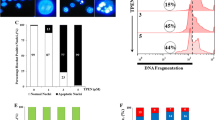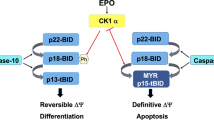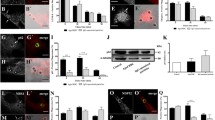Abstract
The presence of P2X7 on erythroid cells is well established, but its physiological role remains unclear. The current study aimed to determine if P2X7 activation induces reactive oxygen species (ROS) formation in murine erythroleukaemia (MEL) cells, a commonly used erythroid cell line. ATP induced ROS formation in a time- and concentration-dependent fashion. The most potent P2X7 agonist, 2′(3′)-O-(4-benzoylbenzoyl)ATP, but not UTP or ADP, also induced ROS formation. The P2X7 antagonist, A-438079, impaired ATP-induced ROS formation. The ROS scavenger, N-acetyl-l-cysteine, and the ROS inhibitor, diphenyleneiodonium, also impaired P2X7-induced ROS formation, but use of enzyme-specific ROS inhibitors failed to identify the intracellular source of P2X7-induced ROS formation. P2X7-induced ROS formation was impaired partly by physiological concentrations of Ca2+ and Mg2+ and almost completely in cells in N-methyl-d-glucamine chloride medium. The p38 MAPK inhibitors SB202190 and SB203580, and the caspase inhibitor Z-VAD-FMK, but not N-acetyl-l-cysteine, impaired P2X7-induced MEL cell apoptosis. ATP also stimulated p38 MAPK and caspase activation, both of which could be impaired by A-438079. In conclusion, these findings indicate that P2X7 activation induces ROS formation in MEL cells and that this process may be involved in events downstream of P2X7 activation, other than apoptosis, in erythroid cells.





Similar content being viewed by others
References
Kaczmarek-Hájek K, Lörinczi E, Hausmann R, Nicke A (2012) Molecular and functional properties of P2X receptors—recent progress and persisting challenges. Purinergic Signal 8:375–417
Wiley JS, Sluyter R, Gu BJ, Stokes L, Fuller SJ (2011) The human P2X7 receptor and its role in innate immunity. Tissue Antigens 78:321–332
Lenertz L, Gavala M, Zhu Y, Bertics P (2011) Transcriptional control mechanisms associated with the nucleotide receptor P2X7, a critical regulator of immunologic, osteogenic, and neurologic functions. Immunol Res 50:22–38
Sluyter R, Stokes L (2011) Significance of P2X7 receptor variants to human health and disease. Recent Pat DNA Gene Seq 5:41–54
Hewinson J, Mackenzie AB (2007) P2X7 receptor-mediated reactive oxygen and nitrogen species formation: from receptor to generators. Biochem Soc Trans 35:1168–1170
Ferrari D, Wesselborg S, Bauer MK, Schulze-Osthoff K (1997) Extracellular ATP activates transcription factor NF-kappaB through the P2Z purinoreceptor by selectively targeting NF-kappaB p65. J Cell Biol 139:1635–1643
Cruz CM, Rinna A, Forman HJ, Ventura ALM, Persechini PM, Ojcius DM (2007) ATP activates a reactive oxygen species-dependent oxidative stress response and secretion of proinflammatory cytokines in macrophages. J Biol Chem 282:2871–2879
Hewinson J, Moore SF, Glover C, Watts AG, MacKenzie AB (2008) A key role for redox signaling in rapid P2X7 receptor-induced IL-1β processing in human monocytes. J Immunol 180:8410–8420
Corrêa G, Marques da Silva C, de Abreu Moreira-Souza AC, Vommaro RC, Coutinho-Silva R (2010) Activation of the P2X7 receptor triggers the elimination of Toxoplasma gondii tachyzoites from infected macrophages. Microbes Infect 12:497–504
Noguchi T, Ishii K, Fukutomi H, Naguro I, Matsuzawa A, Takeda K, Ichijo H (2008) Requirement of reactive oxygen species-dependent activation of ASK1-p38 MAPK pathway for extracellular ATP-induced apoptosis in macrophage. J Biol Chem 283:7657–7665
Moore SF, MacKenzie AB (2009) NADPH oxidase NOX2 mediates rapid cellular oxidation following ATP stimulation of endotoxin-primed macrophages. J Immunol 183:3302–3308
Kawano A, Tsukimoto M, Mori D, Noguchi T, Harada H, Takenouchi T, Kitani H, Kojima S (2012) Regulation of P2X7-dependent inflammatory functions by P2X4 receptor in mouse macrophages. Biochem Biophys Res Commun 420:102–107
Sluyter R, Shemon AN, Barden JA, Wiley JS (2004) Extracellular ATP increases cation fluxes in human erythrocytes by activation of the P2X7 receptor. J Biol Chem 279:44749–44755
Wang L, Olivecrona G, Gotberg M, Olsson ML, Winzell MS, Erlinge D (2005) ADP acting on P2Y13 receptors is a negative feedback pathway for ATP release from human red blood cells. Circ Res 96:189–196
Parker JC, Snow RL (1972) Influence of external ATP on permeability and metabolism of dog red blood cells. Am J Physiol 223:888–893
Sluyter R, Shemon AN, Hughes WE, Stevenson RO, Georgiou JG, Eslick GD, Taylor RM, Wiley JS (2007) Canine erythrocytes express the P2X7 receptor: greatly increased function compared with human erythrocytes. Am J Physiol Regul Integr Comp Physiol 293:R2090–R2098
Stevenson RO, Taylor RM, Wiley JS, Sluyter R (2009) The P2X7 receptor mediates the uptake of organic cations in canine erythrocytes and mononuclear leukocytes: comparison to equivalent human cell types. Purinergic Signal 5:385–394
Skals M, Jorgensenb NR, Leipzigera J, Praetoriusa HA (2009) α-Hemolysin from Escherichia coli uses endogenous amplification through P2X receptor activation to induce hemolysis. Proc Natl Acad Sci USA 106:4030–4035
Skals M, Leipziger J, Praetorius H (2011) Haemolysis induced by α-toxin from Staphylococcus aureus requires P2X receptor activation. Pflugers Arch 462:669–679
Sluyter R, Shemon AN, Wiley JS (2007) P2X7 receptor activation causes phosphatidylserine exposure in human erythrocytes. Biochem Biophys Res Commun 355:169–173
Jiang H, Zhu AG, Mamczur M, Falck JR, Lerea KM, McGiff JC (2007) Stimulation of rat erythrocyte P2X7 receptor induces the release of epoxyeicosatrienoic acids. Br J Pharmacol 151:1033–1040
Chahwala SB, Cantley LC (1984) Extracellular ATP induces ion fluxes and inhibits growth of Friend erythroleukemia cells. J Biol Chem 259:13717–13722
Constantinescu P, Wang B, Kovacevic K, Jalilian I, Bosman GJCGM, Wiley JS, Sluyter R (2010) P2X7 receptor activation induces cell death and microparticle release in murine erythroleukemia cells. Biochim Biophys Acta 1798:1797–1804
Marks PW, Maxfield FR (1991) Preparation of solutions with free calcium concentration in the nanomolar range using 1,2-bis(o-aminophenoxy)ethane-N,N,N′,N′-tetraacetic acid. Anal Biochem 193:61–71
Donnelly-Roberts DL, Namovic MT, Han P, Jarvis MF (2009) Mammalian P2X7 receptor pharmacology: comparison of recombinant mouse, rat and human P2X7 receptors. Br J Pharmacol 157:1203–1214
Bianchi BR, Lynch KJ, Touma E, Niforatos W, Burgard EC, Alexander KM, Park HS, Yu H, Metzger R, Kowaluk EC, Jarvis MF, van Biesen T (1999) Pharmacological characterization of recombinant human and rat P2X7 receptor subtypes. Eur J Pharmacol 376:127–138
Bo XN, Jiang LH, Wilson HL, Kim M, Burnstock G, Surprenant A, North RA (2003) Pharmacological and biophysical properties of the human P2X5 receptor. Mol Pharmacol 63:1407–1416
Acuña-Castillo C, Coddou C, Bull P, Brito J, Huidobro-Toro JP (2007) Differential role of extracellular histidines in copper, zinc, magnesium and proton modulation of the P2X7 purinergic receptor. J Neurochem 101:17–26
Yan Z, Khadra A, Sherman A, Stojilkovic S (2011) Calcium-dependent block of P2X7 receptor channel function is allosteric. J Gen Physiol 138:437–452
Fontanils U, Seil M, Pochet S, El Ouaaliti M, Garcia-Marcos M, Dehaye JP, Marino A (2010) Stimulation by P2X7 receptors of calcium-dependent production of reactive oxygen species (ROS) in rat submandibular glands. Biochim Biophys Acta 1800:1183–1191
Seil M, Fontanils U, Etxebarria I, Pochet S, Garcia-Marcos M, Marino A, Dehaye J-P (2008) Pharmacological evidence for the stimulation of NADPH oxidase by P2X7 receptors in mouse submandibular glands. Purinergic Signal 4:347–355
Martinon F, Mayor A, Tschopp J (2009) The inflammasomes: guardians of the body. Annu Rev Immunol 27:229–265
Donnelly-Roberts DL, Namovic MT, Faltynek CR, Jarvis MF (2004) Mitogen-activated protein kinase and caspase signaling pathways are required for P2X7 receptor (P2X7R)-induced pore formation in human THP-1 cells. J Pharmacol Exp Ther 308:1053–1061
Faria RX, Defarias FP, Alves LA (2005) Are second messengers crucial for opening the pore associated with P2X7 receptor? Am J Physiol Cell Physiol 288:C260–C271
Lenertz L, Gavala M, Hill L, Bertics P (2009) Cell signaling via the P2X7 nucleotide receptor: linkage to ROS production, gene transcription, and receptor trafficking. Purinergic Signal 5:175–187
Harada H, Tsukimoto M, Ikari A, Takagi K, Suketa Y (2003) P2X7 receptor-induced generation of reactive oxygen species in rat mesangial cells. Drug Dev Res 59:112–117
Koopman WJ, Nijtmans LG, Dieteren CE, Roestenberg P, Valsecchi F, Smeitink JA, Willems PH (2010) Mammalian mitochondrial complex I: biogenesis, regulation, and reactive oxygen species generation. Antioxid Redox Signal 12:1431–1470
Li Y, Trush M (1998) Diphenyleneiodonium, an NAD(P)H oxidase inhibitor, also potently inhibits mitochondrial reactive oxygen species production. Biochem Biophys Res Commun 253:295–299
Valko M, Leibfritz DMJ, Cronin MTD, Mazur M, Telser J (2007) Free radicals and antioxidants in normal physiological functions and human disease. Int J Biochem Cell Biol 39:44–84
Hamanaka RB, Chandel NS (2010) Mitochondrial reactive oxygen species regulate cellular signaling and dictate biological outcomes. Trends Biochem Sci 35:505–513
Ghaffari S (2008) Oxidative stress in the regulation of normal and neoplastic hematopoiesis. Antioxid Redox Signal 10:1923–1940
Dana M, Prus E, Fibach E (2012) Thalassemic DNA-containing red blood cells are under oxidative stress. Anemia 2012:943974
Jiang LH, Rassendren F, Mackenzie A, Zhang YH, Surprenant A, North RA (2005) N-methyl-d-glucamine and propidium dyes utilize different permeation pathways at rat P2X7 receptors. Am J Physiol Cell Physiol 289:C1295–C1302
Courageot M-P, Lepine S, Hours M, Giraud F, Sulpice J-C (2004) Involvement of sodium in ealry phophatidylserine exposure and phosolipid scrambling induced by P2X7 purinoceptor activation in thymocytes. J Biol Chem 279:21815–21823
Garcia-Marcos M, Fontanils U, Aguirre A, Pochet S, Dehaye JP, Marino A (2005) Role of sodium in mitochondrial membrane depolarization induced by P2X7 receptor activation in submandibular glands. FEBS Lett 579:5407–5413
Virginio C, Church D, North RA, Surprenant A (1997) Effects of divalent cations, protons and calmidazolium at the rat P2X7 receptor. Neuropharmacology 36:1285–1294
Cankurtaran-Sayar S, Sayar K, Ugur M (2009) P2X7 receptor activates multiple selective dye-permeation pathways in RAW 264.7 and human embryonic kidney 293 cells. Mol Pharmacol 76:1323–1332
Yamaguchi T, Hashiguchi K, Katsuki S, Iwamoto W, Tsuruhara S, Terada S (2008) Activation of the intrinsic and extrinsic pathways in high pressure-induced apoptosis of murine erythroleukemia cells. Cell Mol Biol Lett 13:49–57
Take J, Yamaguchi T, Mine N, Terada S (2001) Caspase activation in high-pressure-induced apoptosis of murine erythroleukemia cells. Jpn J Physiol 51:193–199
Labasi JM, Petrushova N, Donovan C, McCurdy S, Lira P, Payette MM, Brissette W, Wicks JR, Audoly L, Gabel CA (2002) Absence of the P2X7 receptor alters leukocyte function and attenuates an inflammatory response. J Immunol 168:6436–6445
Chessell IP, Hatcher JP, Bountra C, Michel AD, Hughes JP, Green P, Egerton J, Murfin M, Richardson J, Peck WL, Grahames CBA, Casula MA, Yiangou Y, Birch R, Anand P, Buell GN (2005) Disruption of the P2X7 purinoceptor gene abolishes chronic inflammatory and neuropathic pain. Pain 114:386–396
Ke HZ, Qi H, Weidema AF, Zhang Q, Panupinthu N, Crawford DT, Grasser WA, Paralkar VM, Li M, Audoly LP, Gabel CA, Jee WSS, Dixon SJ, Sims SM, Thompson DD (2003) Deletion of the P2X7 nucleotide receptor reveals its regulatory roles in bone formation and resorption. Mol Endocrinol 17:1356–1367
Frascoli M, Marcandalli J, Schenk U, Grassi F (2012) Purinergic P2X7 receptor drives T cell lineage choice and shapes peripheral γδ cells. J Immunol 189:174–180
Testa U (2004) Apoptotic mechanisms in the control of erythropoiesis. Leukemia 18:1176–1199
Nagata S (2007) Autoimmune diseases caused by defects in clearing dead cells and nuclei expelled from erythroid precursors. Immunol Rev 220:237–250
Martins I, Tesniere A, Kepp O, Michaud M, Schlemmer F, Senovilla L, Seror C, Metivier D, Perfettini JL, Zitvogel L, Kroemer G (2009) Chemotherapy induces ATP release from tumor cells. Cell Cycle 8:3723–3728
Groopman JE, Itri LM (1999) Chemotherapy-induced anemia in adults: incidence and treatment. J Natl Cancer Inst 91:1616–1634
Shemon AN, Sluyter R, Conigrave AD, Wiley JS (2004) Chelerythrine and other benzophenanthridine alkaloids block the human P2X7 receptor. Br J Pharmacol 142:1015–1019
Shemon AN, Sluyter R, Stokes L, Manley PW, Wiley JS (2008) Inhibiton of the human P2X7 receptor by a novel protein tyrosine kinase antagonist. Biochem Biophys Res Commun 365:515–520
Shemon AN, Sluyter R, Wiley JS (2007) Rottlerin inhibits P2X7 receptor stimulated phospholipase D activity in chronic lymphocytic leukaemia B-lymphocytes. Immunol Cell Biol 85:68–72
Michel AD, Thompson KM, Simon J, Boyfield I, Fonfria E, Humphrey PPA (2006) Species and response dependent differences in the effects of MAPK inhibitors on P2X7 receptor function. Br J Pharmacol 149:948–957
Acknowledgments
This work was supported by grants from Cure Cancer Australia and the University of Wollongong. We thank Heath Ecroyd (University of Wollongong) and Takuya Noguchi (University of Lausanne) for helpful advice and Aleta Pupovac, Rachael Bartlett (both University of Wollongong) and Iman Jalilian (University of New South Wales) for reviewing the manuscript. Technical support by the staff of the Illawarra Health and Medical Research Institute is also gratefully acknowledged.
Author information
Authors and Affiliations
Corresponding author
Rights and permissions
About this article
Cite this article
Wang, B., Sluyter, R. P2X7 receptor activation induces reactive oxygen species formation in erythroid cells. Purinergic Signalling 9, 101–112 (2013). https://doi.org/10.1007/s11302-012-9335-2
Received:
Accepted:
Published:
Issue Date:
DOI: https://doi.org/10.1007/s11302-012-9335-2




